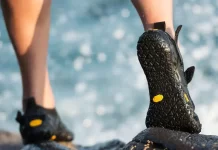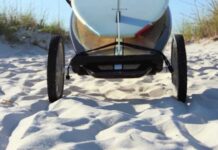If you’ve ever wondered what length leash you need for SUP (stand-up paddle) boarding, you’re not alone. The right leash can make all the difference in ensuring a safe and enjoyable experience on the water. From preventing your board from drifting away to keeping you connected in case of a fall, the leash is an essential piece of equipment. In this article, we’ll explore the factors to consider when choosing the perfect leash length for SUP boarding, helping you make informed decisions for your next adventure on the waves.
Factors to Consider
When it comes to choosing the right leash for paddleboarding, there are a few important factors that we should consider. These factors include the type of paddleboarding we’ll be doing, the water conditions we’ll be facing, and our experience level.
Type of Paddleboarding
First and foremost, we need to determine the type of paddleboarding we’ll be engaging in. There are various types, such as surfing, touring, racing, and yoga paddleboarding. The type of paddleboarding will affect the type of leash we should use. For example, if we’re into surfing, we may prefer a straight leash that allows for quick and easy release when needed.
Water Conditions
Another crucial factor to consider is the water conditions we’ll be paddling in. If we plan to paddle in choppy or rough waters, we may need a leash with additional length and strength to ensure our safety. On the other hand, if we’ll be paddling in calm waters, a shorter leash may be more suitable. It’s essential to assess the specific water conditions and choose a leash accordingly.
Experience Level
Our level of experience also plays a significant role in determining the right leash for paddleboarding. Beginners may benefit from a longer leash that gives them more freedom of movement and helps them maintain balance. As we gain more experience and become more comfortable on the board, we can opt for a shorter leash for better control and maneuverability. It’s crucial to choose a leash that aligns with our skill level to ensure a safe and enjoyable paddleboarding experience.
Types of Leashes
Now that we understand the factors to consider, let’s explore the different types of leashes available for paddleboarding. Each type has its own characteristics and advantages, so let’s take a closer look.
Ankle Leash
The ankle leash is the most common and traditional type of leash for paddleboarding. As the name suggests, it attaches to our ankle via a Velcro strap. The ankle leash is versatile and suitable for various paddleboarding activities. It provides a comfortable and secure connection between us and the board, allowing for easy maneuvering while maintaining the safety of staying connected.
Coiled Leash
A coiled leash is a popular choice among paddleboarders who want to avoid getting tangled in their leash. Unlike an ankle leash, the coiled leash features a spring-like design that keeps it out of the way when not under tension. When extended, the leash offers a considerable length, but it coils back automatically, reducing the risk of entanglement. Coiled leashes are commonly used in surfing or racing paddleboarding, where quick movements and agility are essential.
Waist Leash
A waist leash is an alternative to ankle leashes, providing a different attachment point. With a waist leash, the connection is made around our waist, allowing for more freedom of movement and minimizing the risk of the leash interfering with paddle strokes. This type of leash can be particularly beneficial for paddleboarders who engage in activities such as yoga or fishing, where unrestricted movement is essential.
Straight Leash
Similar to an ankle leash, a straight leash attaches to our ankle. However, unlike the more common coiled design, a straight leash offers a fixed length without the automatic coiling feature. Straight leashes provide excellent stability and are suitable for paddleboarders who value simplicity and don’t mind the slight drag caused by the leash in the water.
Leash Length
Next, let’s dive into the different leash lengths available and explore their advantages and best use cases.
Short Leash (6 feet or less)
A short leash is typically around 6 feet or less in length. This type of leash is ideal for paddleboarding in calm waters or confined areas, where freedom of movement is not a concern. Short leashes offer optimum control and reduce the risk of entanglement.
Medium Leash (7-9 feet)
A medium leash, ranging from 7 to 9 feet, strikes a balance between control and freedom of movement. It’s suitable for paddleboarding in various conditions, providing enough length to maintain a safe connection while allowing some flexibility for maneuvering and balance adjustments.
Long Leash (10-12 feet)
For paddleboarding in more challenging conditions, or when greater freedom of movement is desired, a long leash ranging from 10 to 12 feet may be the best choice. The additional length allows for increased mobility and is commonly used by experienced paddleboarders in rough waters or during activities that require more agility, such as surfing or racing.
Customizable Leash Lengths
Some leash manufacturers offer customizable leash lengths to cater to specific needs or personal preferences. Customizable leashes can be a great option if none of the standard leash lengths suit our requirements. They allow us to choose the exact length that provides the right balance of control and freedom of movement for our paddleboarding style.
Choosing the Right Leash Length
Now that we have an understanding of the different factors to consider and the types of leashes available, let’s explore how to choose the right leash length for our paddleboarding adventures.
Consider your Board Size
The size of our paddleboard plays a crucial role in determining the appropriate leash length. Longer boards typically require longer leashes to ensure we remain connected to the board in case of falls or unexpected situations. Conversely, shorter boards may benefit from shorter leashes to maintain control and prevent unnecessary drag in the water.
Consider your Paddle Style
Our paddle style also influences the ideal leash length. If we prefer a more aggressive and dynamic paddle style, a shorter leash may be the better option as it offers increased maneuverability and responsiveness. Conversely, a more relaxed and steady paddle style may warrant a longer leash to provide a greater range of motion.
Consider your Style of Paddleboarding
The type of paddleboarding we engage in should also inform our leash length selection. If we’re into activities that require quick and frequent movements, such as surfing or rapid touring, a shorter leash allows us to react swiftly and maintain control. On the other hand, if we prioritize stability and balance for activities like yoga or fishing, a longer leash may be more suitable.
Consider any Specific Needs or Preferences
Lastly, we should consider any specific needs or preferences we have concerning leash length. Factors such as body size, comfort, and personal limitations should be taken into account. It’s essential to choose a leash length that allows us to feel comfortable, confident, and safe while paddleboarding.
Safety Considerations
Now that we’ve discussed the different factors to consider and how to choose the right leash length, let’s shift our focus to safety considerations when using a leash for paddleboarding. Ensuring our safety and the safety of those around us is of utmost importance, so here are some essential safety tips to keep in mind.
Avoid Leashes that are Too Long
While longer leashes can provide more freedom of movement, it’s crucial to avoid using leashes that are excessively long for the given conditions. Long leashes can become entangled in objects or vegetation, increasing the risk of accidents. Additionally, longer leashes may limit our ability to control the board effectively, especially in more challenging waters.
Ensure Proper Fit and Attachments
Before heading out on the water, it’s essential to check that our leash fits properly and is securely attached. A loose leash can easily slip off during falls or sudden jolts, rendering it useless. Conversely, a leash that is too tight can restrict our movement and cause discomfort. Ensuring a snug and comfortable fit is crucial for optimal safety.
Be Mindful of Leash Tangles
Tangles in our leash can lead to dangerous situations, potentially causing injuries or impairing our ability to control the board. To minimize the risk of tangles, it’s important to be mindful of the leash’s position during paddleboarding sessions. Regularly check for any twists or knots and untangle them to maintain a clear and safe connection to the board.
Practice Self-Rescue Techniques
No matter how cautious we are, accidents can still happen. Practicing self-rescue techniques is essential in case we become separated from our board. Learning how to swim efficiently and safely to shore, how to retrieve a lost board, and how to react in different emergency scenarios is crucial for our safety when paddleboarding.
Tips for Using a Leash
Now that we understand the safety considerations associated with leash usage, let’s explore some general tips for using a leash effectively and responsibly.
Attach the Leash Correctly
Properly attaching the leash is vital for its functionality. Ensure that the ankle strap or waist attachment is secure, and the connection between the leash and the board is strong. Taking a moment to double-check the attachment before heading out on the water can save us from potential accidents or a lost board.
Keep the Leash Clear from Obstructions
Throughout our paddleboarding session, it’s important to keep the leash clear from any obstructions or potential entanglement hazards. Be aware of your surroundings, including nearby objects, vegetation, or other watercraft, to avoid any unnecessary risks. Maintaining a clear and unobstructed leash position contributes to a safe and enjoyable paddleboarding experience.
Practice Proper Paddle Technique
Using the correct paddle technique not only improves efficiency but also reduces the risk of falling off the board and potentially getting tangled in the leash. Invest time in learning and refining proper paddle technique to enhance stability, control, and minimize the chances of accidents or incidents with the leash.
Inspect and Maintain your Leash
Regularly inspecting and maintaining our leash is essential for its longevity and effectiveness. Check for signs of wear, such as fraying or weakening attachments, and promptly replace any damaged or worn-out parts. By caring for our leash, we can ensure it remains robust and reliable, supporting us throughout many paddleboarding adventures.
Understanding Leash Laws and Regulations
As responsible paddleboarders, it’s crucial to have an understanding of leash laws and regulations in our local area. Different jurisdictions may have specific requirements regarding leash usage, and it’s our responsibility to comply with these regulations. Familiarize yourself with local laws and ensure you have the appropriate leash and usage practices to promote safety for yourself and others.
Research Local Laws and Regulations
Start by researching the leash laws and regulations in your area before embarking on any paddleboarding activities. Understand the requirements set by local authorities and take the necessary steps to comply with them. Stay informed about any updates or changes to the legislation to ensure you remain within the bounds of the law.
Understand the Importance of Leash Usage
Leash laws and regulations are put in place to ensure the safety of paddleboarders, other water users, and the environment. Understanding the importance of leash usage goes beyond mere compliance with the law. Using a leash is a responsible choice that minimizes the chance of board drift, collisions, and keeps you connected to your board in case of falls or accidents.
Be a Responsible Paddleboarder
In addition to complying with leash laws, being a responsible paddleboarder involves considering the well-being of others, the environment, and promoting safety. Respect other water users, follow designated routes or rules, and keep the waterways clean. By cultivating a responsible and considerate approach, we can contribute to a safe and enjoyable paddleboarding community.
Common Leash Mistakes to Avoid
Despite understanding the importance of using a leash and the necessary safety considerations, it’s essential to be aware of common leash mistakes and avoid them.
Choosing the Wrong Length
Selecting the wrong leash length can compromise our safety and enjoyment during paddleboarding. Failing to assess the water conditions, paddle style, or board size when choosing the leash length increases the risk of accidents. Take the time to evaluate these factors and choose the appropriate leash length for your specific needs.
Neglecting to Use a Leash
The most significant mistake one can make is neglecting to use a leash altogether. Paddleboarding without a leash significantly increases the risk of accidents, injury, or loss of a board. It’s always best to use a leash, regardless of the conditions or our experience level, to ensure the safety of ourselves and others.
Using a Worn-out or Damaged Leash
Continuing to use a leash that is worn-out or damaged poses significant safety risks. Frayed cords, weakened attachments, or malfunctioning components can lead to sudden leash failure. Regularly inspect your leash and promptly replace any parts that show signs of damage or wear.
Using the Wrong Type of Leash
Using the wrong type of leash for your specific paddleboarding activity can hinder your experience. Each type of leash serves a different purpose, and using the wrong one may compromise your safety or restrict your movement. Take the time to understand the various leash types and select the one that aligns with your paddleboarding style and preferences.
Conclusion
Choosing the right leash for paddleboarding is a crucial safety consideration that can greatly enhance our experience on the water. By considering factors such as the type of paddleboarding, water conditions, and experience level, we can determine the most suitable leash for us. Remember to select a leash length that aligns with your board size, paddle style, and style of paddleboarding. Always prioritize safety by avoiding leash tangles, practicing self-rescue techniques, and adhering to leash laws and regulations. With these tips and considerations in mind, you’ll be well-equipped to enjoy paddleboarding safely and responsibly.





































